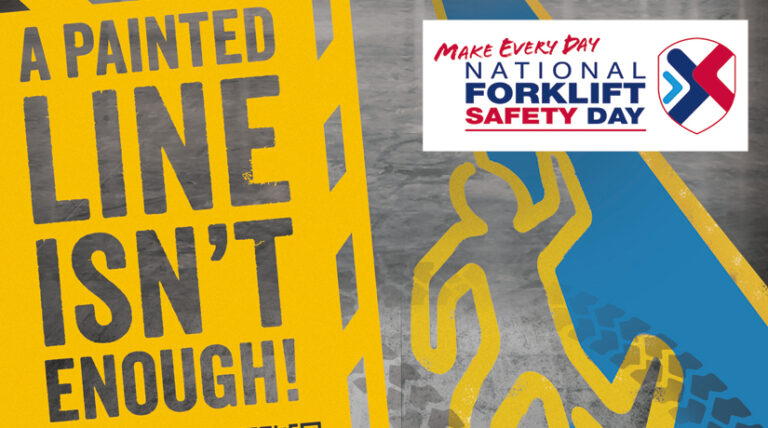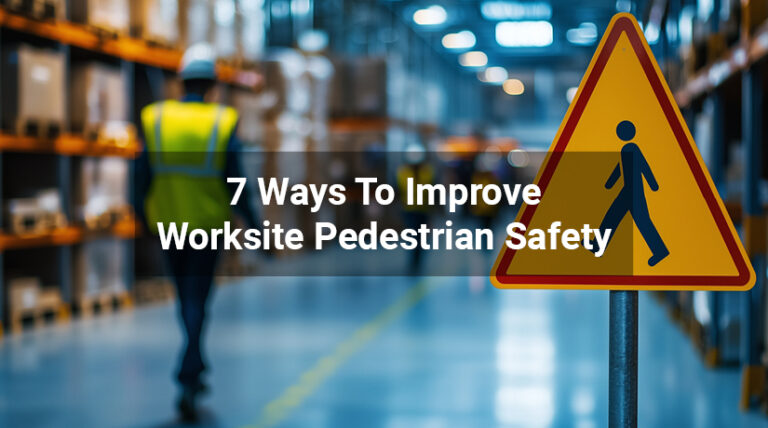Pedestrian Segregation in the workplace is important for reducing risk on sites wherever vehicles work in close proximity with pedestrians. Implementing effective forklift and pedestrian separation strategies significantly minimizes the chances of accidents and ensures a safer working environment.
While introducing speed limits on-site can help reduce the risk of accidents, the most simple and effective way for companies to protect their staff is to physically separate pedestrian walkways in the workplace from forklift traffic routes. Additionally, using forklift exclusion zone lights enhances visibility and acts as a visual warning for both pedestrians and vehicle operators, reducing the likelihood of collisions.
There are several ways that you can achieve this – from barriers and raised kerbs to LED lighting and proximity warning systems, all contributing to effective vehicle pedestrian segregation.
But what can happen if you don’t segregate? Fines, prosecutions and deaths, to be blunt.
Here are some recent examples of when pedestrian segregation could have avoided all of the above.
Construction:
A Stratford construction company was fined £1million after a worker was struck by an excavator and killed.
Southwark Crown Court heard how in 2014, during night work at a construction site, a site operative, Kevin Campbell was struck by an excavator-mounted vibrator (EMV) that was attached to a 35-tonne excavator that he was working close to. Mr Campbell had been disconnecting lifting accessories from a metal pile that had just been extracted from the ground when he was crushed against a concrete wall a short distance away.
An investigation by the Health and Safety Executive (HSE) found that the construction company, Clancy Docwra Limited, failed to ensure the safety in the workplace so far as it is reasonably practicable of its employees and of others (who were not employees) working on site.
Clancy Docwra pleaded not guilty to breaching Section 2(1) and 3(1) of the Health and Safety at Work Act 1974. The company was found guilty and fined £1,000,000. They were also ordered to pay costs of £108,502.30. An HSE inspector spoke about the case after the hearing:
“This death was wholly preventable. If the risks had been properly considered by the company, and simple and appropriate measures were put in place, then the likelihood of such an incident in the workplace would have been significantly reduced. Informing all site operatives of the specific risks and controlled measures including exclusion zones would also lower the risk.”
Segregation and exclusion zones would have avoided this incident and prosecution.
Segregation and exclusion zones would have avoided this incident and prosecution.
Recycling:
A recycling site labourer died after being run over by a wheeled front-loading shovel. George Richardson, 56, was run over by the loading shovel at Sanders Plant and Waste Management site in Pegswood, Northumberland on 15 June 2015.
The Health and Safety Executive (HSE) found a lack of pedestrian and vehicle segregation in the workplace. The company had carried out a risk assessment before the incident and identified some control measures to reduce the risks from operating the loading shovel and a forklift truck.
The plant was fined a huge £500,000 after pleading guilty to breaching reg 2(1) of the Health and Safety at Work (HSW) Act. They also had to pay £14,042 in costs.
They admitted that there were no separate entrances or exits for vehicles and pedestrians in place, or segregated walkways in the shed or out of the doors.
It was agreed that walkways (and therefore pedestrian segregation) would have been a reasonable practical measure and the company failed to ensure the health and safety of employees working in the shed.
Segregation of people and vehicles would have provided a prevention.
Segregation of people and vehicles would have provided a prevention.
Warehousing & Logistics
A warehousing company in Bracknell was hit with a £60,000 fine after a staff member was run over with a forklift truck. The man was taken to hospital after his ankle was run over. He suffered damage to his ankle ligaments and heel, which happened in the early morning of July 2016.
It was later revealed that the driver who had caused the accident had been given insufficient forklift training just 17 days earlier – and that the company had previously been warned about its forklift training processes in the workplace.
The company in Binfield admitted three offences under the Health and Safety at Work Act 1974. There were also two additional charges that reflected various failures – including failing to provide suitable traffic routes for people and vehicles, and failing to ensure that all persons who use work equipment receive adequate training – particularly for when using forklift trucks.
Segregation of people and vehicles would have provided a prevention.
How can your company segregate?
Peter Harvey, chief executive at the FLTA (Fork Lift Truck Association) states that under the legislation for The Health and Safety at Work Act (1974) companies are responsible for the health and safety of their employees. This legislation outlines the responsibility to carry out suitable and sufficient risk assessments. The regulations include requirements for:
- The organisation of traffic routes to enable pedestrians and vehicles to navigate safely
- Floor and traffic routes in the workplace to be constructed to that they are suitable for the purpose for which they will be used, and do not expose users to health and safety risks
- Sufficient lighting so that people can work and move around safely
- Doors and gates on traffic routes to be fitted with a transparent viewing panel which gives a clear view, when shut, of the areas on the other side.
What happens when you cannot segregate in the workplace?
There are, of course, times when you cannot fully segregate pedestrians and vehicles in the workplace. Some sites often require workers to cross the path of heavy-duty vehicles traveling at speed. Crossing points and pedestrian walkways in the workplace are a great solution, but accidental collisions can still occur – due to blind corners, busy or noisy environments, and staff unfamiliarity with the site layout.
ZoneSafe has the solution.
ZoneSafe’s Walkway and Crossing Alert is a Proximity Detection System, using Radio Frequency Identification (RFID) that helps to reduce accidental collisions through audible and visual warnings, ensuring that your pedestrian worker is aware of any oncoming vehicles.
System Overview
The standard ZoneSafe Vehicle to Person Alert System is fitted to the vehicle, with a detection antenna. The ZoneSafe Vehicle Detection Unit is positioned near the pedestrian crossing, walkway or blind corner – wherever there is chance of collisions. This is also connected to warning lights located on the crossing or walkway.
The ZoneSafe Vehicle Detection Unit detects an approaching vehicle. Once detected, it activates warning lights located at the crossing point. This warns the pedestrian of any incoming vehicles – and indicates whether it is safe to cross.
This application can ALSO be set up with a barrier system. The Vehicle Detection Unit can ensure that the barrier or gate automatically closes when vehicles approach a crossing or walkway. The barrier will only open when the walkway is clear of vehicles, reducing the chances of an accident.
To find out more about ZoneSafe’s suite of products, visit www.zonesafe.net.




